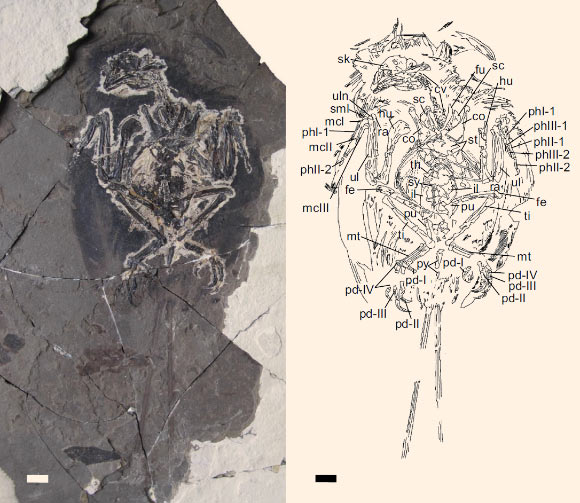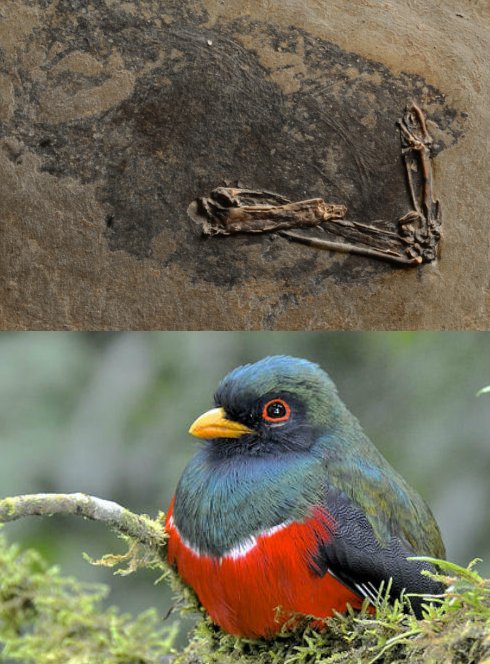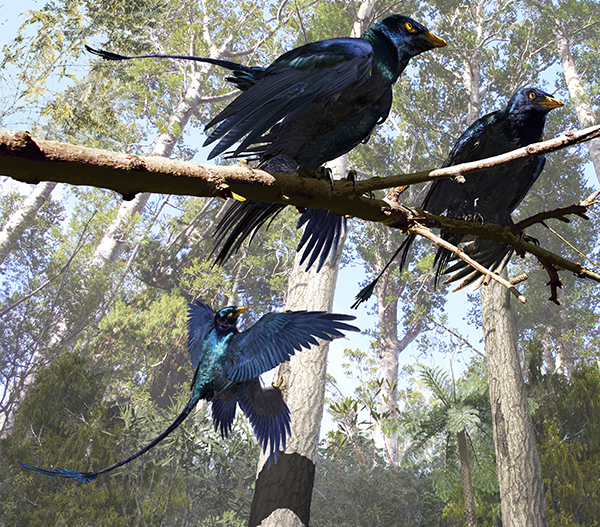A group of paleontologists led by University of Akron researcher Jennifer Peteya has discovered a new bohaiornithid bird specimen from the Cretaceous period of China with remarkably preserved feathers.

Ventral view of the new bohaiornithid specimen. Left: photograph of the primary slab. Right: interpretive drawing. Abbreviations: co – coracoid; cv – cervical vertebrae; fe – femur; fu – furcula; hu – humerus; il – ilium; mcI-III – metacarpals I–III; mt – metatarsals; pd I–IV – pedal digits I–IV; phI-1 – first phalanx of digit I; phII/III-1/2 – first/second phalanx of digit II/III; pu -pubis; py – pygostyle; ra – radius; sc – scapula; sk – skull; sml – semilunate carpal; st – sternum; sy – synsacrum; th – thoracic vertebrae; ti – tibia; ul – ulna; uln – ulnare. Scale bar – 1 cm. Image credit: Jennifer A. Peteya et al, doi: 10.1111/pala.12270.
Bohaiornithid birds belonged to Enantiornithes, a diverse group of birds that lived during the time of the dinosaurs.
Our current knowledge of prehistoric plumage is limited, but the new findings provide valuable insights related to structure and coloration.

“Many enantiornithine birds possessed ornate feathers,” said Peteya, a Ph.D. student in the Department of Biology and Integrated Bioscience Program at the University of Akron.
“This new specimen shows that some enantiornithines also had iridescent feathers and unlike most modern birds, these flashy ornaments developed before the animal was fully grown.”
The specimen was collected from the Jiufotang Formation near Lamadong Village in Liaoning Province, China.
It consists of a nearly complete skeleton with preserved melanized feathers.

“A white ‘halo’ surrounds and intermingles with skeletal elements and obscures the proximal ends of feathers,” Peteya and co-authors noted.
“A similar ‘halo’ has previously been described in Microraptor sp. and was suggested to be the result of changes in matrix chemistry due to water being trapped between the feathers and the body.”
With a mixture of juvenile and subadult skeletal characteristics, the new bohaiornithid specimen preserves feather morphologies indicative of sexual maturity.
“Exce ptionally-preserved feathers cover the body, including elongate crown feathers, body contour feathers, asymmetrically-veined wing primaries, an alula and two elongate rachis-dominated rectrices that may have been sexual ornaments,” the authors said.
ptionally-preserved feathers cover the body, including elongate crown feathers, body contour feathers, asymmetrically-veined wing primaries, an alula and two elongate rachis-dominated rectrices that may have been sexual ornaments,” the authors said.
“The crown, neck, and body contour feathers retain elongate melanosome morphologies associated with weakly iridescent coloration in extant feathers.”
“The new specimen presents a combination of juvenile skeletal features and display-linked plumage characteristics that inform the role of sexual selection in Enantiornithes,” they added.
“Currently, there is comparatively little evidence available for ontogenetic shifts in morphology within Bohaiornithidae and the new specimen is the smallest and possibly the youngest bohaiornithid yet described.”
Source: sci.news








